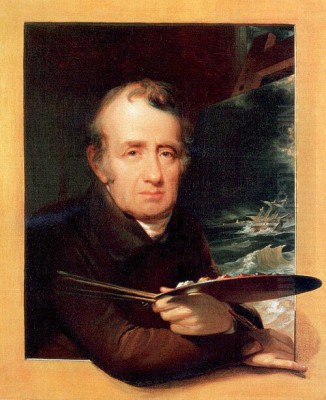
Thomas Birch (1779-1851) stands as a significant figure in the early development of American art. Born in England, he immigrated to the United States and became one of the nation's foremost painters of marine subjects and landscapes during the late eighteenth and early nineteenth centuries. His work bridged European artistic traditions with the burgeoning identity of the new American nation, capturing both its natural beauty and its historical moments with remarkable skill and sensitivity. His legacy is defined by his foundational role in establishing distinctly American genres of painting.
Early Life and Artistic Foundations in Philadelphia
Thomas Birch was born in London, England, in 1779. He was the son of William Russell Birch (1755-1834), an accomplished painter and engraver known particularly for enamel miniatures. The Birch family's move to Philadelphia in 1794 proved pivotal for young Thomas's artistic development. Philadelphia was then the cultural and political heart of the young United States, providing a stimulating environment for an aspiring artist.
Under his father's tutelage, Thomas received his primary art education. William Birch instructed his son in drawing, engraving, and painting techniques. This apprenticeship model was common at the time, and Thomas quickly absorbed the skills necessary for a professional artistic career. He did not pursue formal academic training but learned through direct practice and collaboration with his experienced father.
A significant early project undertaken by father and son was The City of Philadelphia, in the State of Pennsylvania North America; as it Appeared in the Year 1800. This ambitious series, often referred to as Birch's Views of Philadelphia, consisted of twenty-nine engraved plates depicting the city's streetscapes, important buildings, and scenic environs. Thomas assisted his father significantly in the drawing and engraving process, gaining invaluable experience in topographical representation and printmaking. This series remains an important visual record of Federal-period Philadelphia.
The Turn to the Sea: Marine Painting
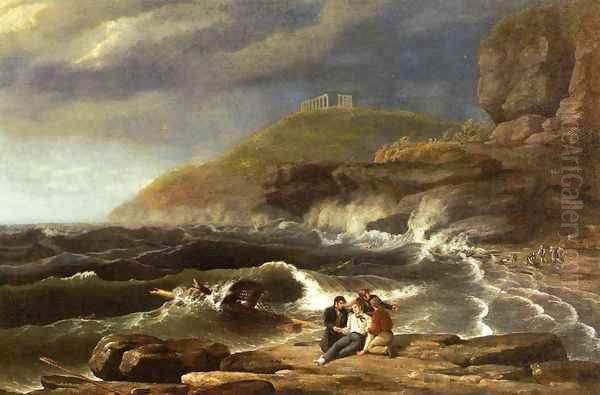
While initially involved in various artistic pursuits including portraiture and assisting his father with engravings, Thomas Birch found his true calling in marine painting around 1807. A visit to the capes of the Delaware River reportedly sparked his fascination with the sea and shipping. This shift marked the beginning of his specialization in a genre where he would become a leading American practitioner.
His timing coincided with a period of heightened maritime activity and national consciousness surrounding naval power. The United States was asserting itself on the world stage, and events like the Quasi-War with France and escalating tensions with Great Britain brought naval affairs to the forefront. Birch's burgeoning interest in marine subjects placed him in an ideal position to document this era.
His early marine works began to establish his reputation, showcasing his ability to capture the dynamic qualities of water, sky, and sailing vessels. He developed a keen eye for the details of ship construction and rigging, combined with an ability to convey the atmosphere of the maritime environment, from calm harbors to stormy seas. This focus laid the groundwork for his most celebrated works during the War of 1812.
Chronicler of the War of 1812
The War of 1812 provided Thomas Birch with his most compelling subject matter and cemented his fame. The conflict, largely fought at sea or along the coast, generated intense public interest in naval engagements. Birch responded by creating a series of dramatic paintings depicting key battles between American and British warships. These works were not only artistically accomplished but also served a patriotic purpose, celebrating American naval prowess.
Among his most famous works from this period is The Engagement between the USS United States and HMS Macedonian, painted shortly after the actual battle in October 1812. This painting, and others like The Engagement between the USS Constitution and HMS Guerriere and The Wasp and the Frolic (c. 1820), captured the intensity and chaos of naval combat with remarkable detail and energy. Birch often based his depictions on eyewitness accounts and ship plans to ensure accuracy.
These naval battle scenes were widely acclaimed and reproduced as engravings, reaching a broad audience. They resonated with national pride and established Birch as the preeminent American marine painter of his generation. His ability to combine documentary accuracy with dramatic composition made these works powerful visual narratives of the young nation's military history. His focus on these contemporary events distinguished him from artists primarily looking to European historical or mythological themes.
Depicting the American Landscape
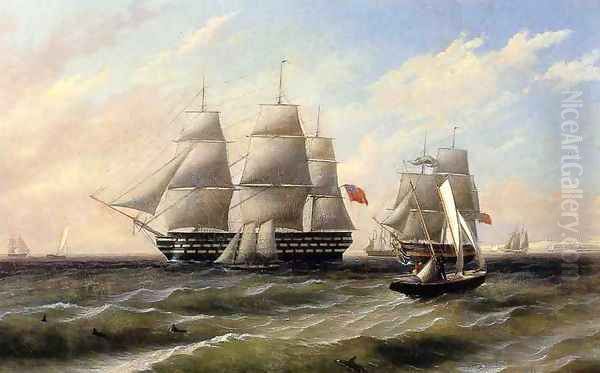
Alongside his celebrated marine paintings, Thomas Birch was also a significant contributor to the development of American landscape painting. While perhaps less famous than his seascapes, his landscapes possess a distinct charm and historical importance. He began painting landscapes early in his career, sometimes collaborating with his father on views intended for engraving.
Birch's landscape style often favored tranquil, pastoral scenes rather than the dramatic, sublime wilderness later championed by the Hudson River School painters. His views frequently depicted the settled countryside around Philadelphia, the Schuylkill River, and the Delaware River Valley. He had a particular fondness for winter scenes, capturing the crisp light and quiet beauty of the snow-covered American landscape with sensitivity. Works like View of the Dam and Water Works at Fairmount, Philadelphia (c. 1821) showcase this aspect of his oeuvre.
His approach was influenced by seventeenth-century Dutch landscape painting and eighteenth-century picturesque traditions from Europe, but adapted to the specific light and topography of the American Mid-Atlantic region. His landscapes offered a gentler, more domesticated vision of nature compared to the untamed vistas that would later dominate American landscape art. An early example related to landscape, though topographical, is the engraving Penn's Treaty Tree (1804).
Artistic Style, Influences, and Techniques
Thomas Birch's artistic style can be characterized as a form of Romantic Realism. He grounded his work in careful observation of nature and meticulous attention to detail, particularly evident in his rendering of ships and architecture. However, he infused his scenes with atmospheric effects and a sense of drama or tranquility that aligns with Romantic sensibilities. His handling of light and water was particularly adept, capturing reflections, transparency, and movement with convincing skill.
The most significant artistic influence on Birch was undoubtedly his father, William Russell Birch, who provided his foundational training. Through his father and the artistic environment of London and Philadelphia, he would have been exposed to British marine painting traditions, possibly including the work of artists like Nicholas Pocock. Dutch Golden Age painting, especially the marine works of artists like Willem van de Velde the Younger and landscape painters such as Jacob van Ruisdael, also seems to have informed his style, particularly in composition and atmospheric treatment.
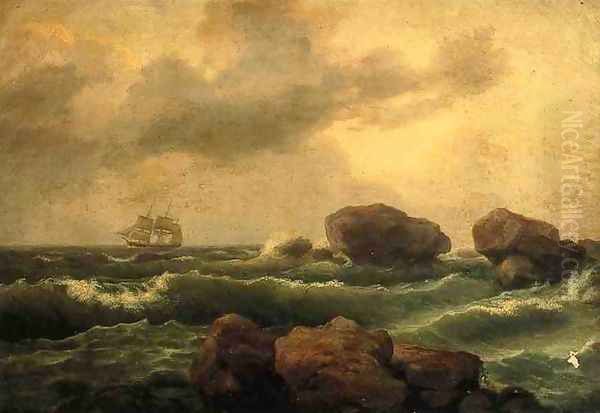
Some art historians suggest a possible influence from the French marine painter Claude Joseph Vernet, known for his dramatic shipwrecks and coastal scenes. Birch did paint shipwrecks, such as his notable Shipwreck (1829), which shares thematic ground with Vernet's work. Birch primarily worked in oil on canvas or wood panel, applying paint with controlled brushwork that allowed for both fine detail and broader atmospheric effects. His use of prints to disseminate his popular compositions was also a key part of his practice.
Notable Works and Museum Collections
Thomas Birch produced a substantial body of work during his long career. Several key paintings represent his artistic achievements and are held in major museum collections:
USS United States vs HMS Macedonian (versions c. 1813): Depicting the famous naval victory, versions are held by institutions like the Pennsylvania Academy of the Fine Arts (PAFA) and the Historical Society of Pennsylvania.
Shipwreck (1829): A dramatic representation of maritime disaster, housed in the Brooklyn Museum.
The Wasp and the Frolic (c. 1820): Another dynamic War of 1812 naval battle scene. (Location note: source mentioned Flammer Gallery, verification needed; likely in private or other public collection).
Ship at Sea (1802): An early example of his marine focus, located at the Wichita Art Museum.
View of the Dam and Water Works at Fairmount, Philadelphia (c. 1821): A fine example of his landscape work, held by PAFA.
Seascape (1835): A later marine painting showcasing his mature style.
Winter Scene (various dates): Birch painted numerous winter landscapes, which are found in various collections, appreciated for their atmospheric quality.
His works are represented in numerous prestigious institutions across the United States, including the Metropolitan Museum of Art, the National Gallery of Art, the Smithsonian American Art Museum, the Philadelphia Museum of Art, and the U.S. Naval Academy Museum, among others.
Professional Life, Recognition, and Challenges
Thomas Birch was an active member of the Philadelphia art community throughout his career. He regularly exhibited his paintings at the annual exhibitions of the Pennsylvania Academy of the Fine Arts (PAFA), one of the oldest and most important art institutions in the country. His consistent participation helped solidify his reputation and brought his work to the attention of collectors and fellow artists.
His contributions were recognized beyond Philadelphia. He was elected an Honorary Member of the National Academy of Design in New York in 1833, a significant acknowledgment of his status in the American art world. Some sources also mention a connection to coin design for the United States Mint in Philadelphia, although this aspect of his career requires further verification. His primary income, however, came from the sale of paintings and prints derived from them.
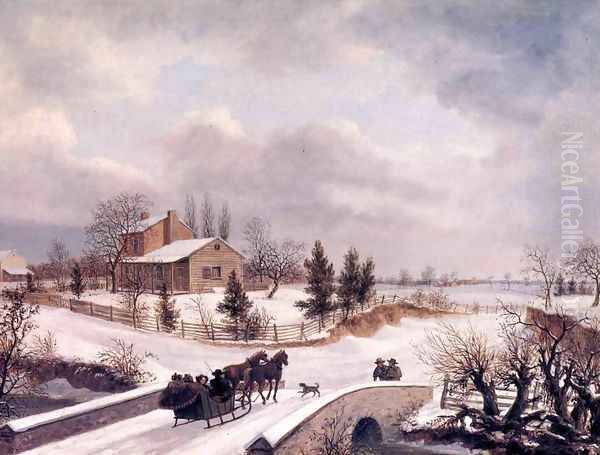
Despite his artistic success and recognition, Thomas Birch reportedly faced financial difficulties later in life. Like many artists of the period, securing consistent patronage could be challenging. The market for American art was still developing, and even established artists could struggle financially. His later years were marked by relative poverty, a poignant contrast to the national acclaim his War of 1812 paintings had brought him decades earlier. He continued painting until his death in Philadelphia in 1851.
Influence and Legacy in American Art
Thomas Birch's influence on subsequent generations of American artists was considerable, particularly in the realms of marine and landscape painting. As one of the first highly skilled, professional artists specializing in these genres in the United States, he set a standard and provided inspiration for many who followed.
His impact on the Hudson River School is notable. The renowned landscape painter Thomas Cole (often considered the founder of the school) is said to have been inspired to take up landscape painting after seeing Birch's work exhibited at PAFA. While Cole and later Hudson River School artists like Asher B. Durand and Frederic Edwin Church developed a grander, more overtly Romantic vision of the American wilderness, Birch's earlier, quieter landscapes helped pave the way. Other early landscape contemporaries included Alvan Fisher and Thomas Doughty.
In marine painting, Birch's influence extended to artists like James Hamilton, a Philadelphia painter known for his dramatic seascapes, and George Robert Bonfield, another Philadelphia marine specialist, both of whom Birch may have mentored or advised. His work also predates and likely influenced the Luminist painters, including Fitz Henry Lane, who shared an interest in precise ship portraiture and atmospheric coastal light, though Lane developed a distinctively serene and light-focused style. Other important marine painters active during or shortly after Birch's time include the British immigrant Robert Salmon, working in Boston, and later figures like William Trost Richards and Martin Johnson Heade, who continued to explore coastal and marine themes.
Thomas Birch's legacy rests on his pioneering role in establishing marine and landscape painting as important American genres. He skillfully adapted European artistic conventions to depict American subjects, from the bustling port of Philadelphia to the dramatic naval battles that shaped the nation's identity. His detailed, atmospheric, and often patriotic works provide invaluable visual records of his time and secured his place as a foundational figure in the history of American art.
Conclusion
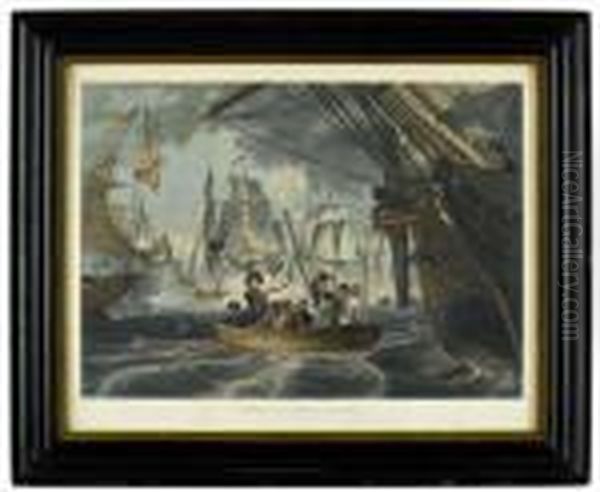
Thomas Birch navigated the transition from colonial artistic dependence to the formation of a distinctly American art. Trained by his immigrant father, he embraced the landscape and maritime life of his adopted country. His meticulous engravings of Philadelphia, his dramatic and patriotic depictions of the War of 1812 naval battles, and his serene landscapes collectively form a rich portrait of the early American republic. Though facing personal financial struggles, his professional recognition and influence on key figures like Thomas Cole and Fitz Henry Lane underscore his importance. Birch remains a vital artist for understanding the origins of marine and landscape painting in the United States.